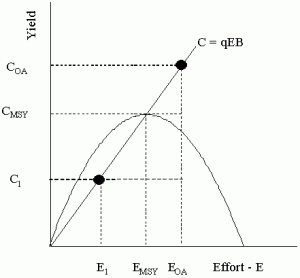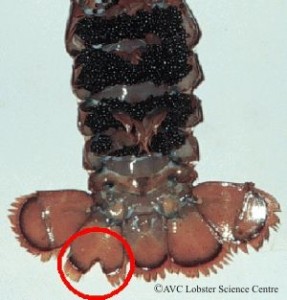

![]() In 1954 and 1957 Gordon and Schaefer respectively described the idea of maximum sustainable yield (MSY) – that is, the amount of fish that could be taken by commercial fishing operations to maximize reproduction by the system year after year. Since then, it has been heralded as the mathematical panacea to fisheries management.
In 1954 and 1957 Gordon and Schaefer respectively described the idea of maximum sustainable yield (MSY) – that is, the amount of fish that could be taken by commercial fishing operations to maximize reproduction by the system year after year. Since then, it has been heralded as the mathematical panacea to fisheries management.
Gordon and Schaefer also described the maximum economic yield which threw price relations into the mix. It describes the point at which the fishers will make the most money, accounting for revenue and their expenses. Note in the graph below the fold that the maximum economic yield (MEY) is below the MSY in terms of effort. Gordon and Schaefer imagined a private manager or government overseer that could calculate the MEY and regulate fisher behavior in order to meet it. The idea was meant to be win-win for the fishers and the fish.

The graph above is usually how MSY is described. The upside down U curve describes revenue based on the catch yield. MSY harvests at the highest rate of growth, just before the removal of too many fish will cause a decrease in reproduction. The straight line describes cost to the fisher (gas, boat expenses, crew salaries). MEY (here E1) is the point at which the fishermen will gain maximum profit per fish they catch. Open access conditions (here Eoa) is when fishermen will be economically forced to stop because the profits they make equal the expenses toward fishing effort.
Granted, either MEY or MSY is better than open access, right? The situation prior to MSY thinking was described as “the race to fish” where every boat was out for their own best interest in the short-term. Since no one else was looking out for the future of the resource, it was safe to assume that the resource is non-renewable and therefore it makes the most rational economic sense to join in the same race. This assumes both perfect rational behavior on the part of the fisher and costs and revenues that follow a predictable pattern like those shown in the graph.
The MSY model also assumes that yield increases with effort until MSY is reached and that beyond that, replacement is slower due to a lower population size. Underlying that assumption is another in which fish population follow a classic sigma curve – slow growth at low and high populations, exponential growth in the middle. It also assumes that the cause-effect link is only one year long and that fishing behavior in one year will directly determine the next year’s stock. Gordon (1954) himself noted, however “large broods, however, do not appear to depend on large numbers of adult spawners, and this lends support to the belief that the fish population is entirely unaffected by man”. There are still small armies of graduate students out there attempting to characterize the population growth curve of major fishery species.
The assumptions continue, however. The model is single-species specific and doesn’t take into account any damage done to the ecosystem through fishing effort or outside factors that affect the fish stock related to the ecosystem at large. This is huge in an era of climate change and more widely recognized interacting factors. Furthermore, the model is a closed system, where there is no connectivity to other stocks, which in the case of cod (Kurlansky’s book), lobster (Wilson et al) and likely many other species, each stock is connected to others either farther inshore or offshore in terms of larval or juvenile transport.

Taking a big step up in scale, later work by Elinor Ostrom and more fisheries specific by Bonnie McKay and James Wilson question the assumption of tragedy of the commons. They documented real-life communities that despite incentives to participate in the race to fish, managed to self-organize to manage their commons in a sustainable manner for hundreds if not thousands of years. None of these systems used an MSY-like model and none had a central private or government decision-maker. In fact, there were several cases like those of the western Pacific (Conservation International) where disruption of the local management schemes actually led to fishery depletion and coral reef degradation, so there are recent efforts to restore traditional management techniques. These techniques rely upon social mechanisms and context-specific regulations. These concepts are worth a volume of books, but those have already been written and can be found sprouting out of the labs of Ostrom, McKay, and Wilson as well as their academic progeny.
For now, suffice it to say that MSY is simplistic and outdated. Marine management is on the edge of a shift towards a completely new management philosophy based more strongly in specific contexts and traditionally proven strategies.
~Bluegrass Blue Crab
Sources: Ostrom, E. 2002. Drama of the Commons. Washington, D.C.: National Academies Press.
Gordon, H. (1954). The Economic Theory of a Common-Property Resource: The Fishery Journal of Political Economy, 62 (2) DOI: 10.1086/257497
Good discussion of one of my favorite topics. You should add, however, that there is another layer thrown on to the “Maximum Sustainable Yield” when it comes to fisheries management. The model you describe is used to recommend the MSY decreed by regulation, And by law, most fisheries cannot catch beyond that regulatory MSY (as discussed a lot on shows like The Deadliest Catch when they’re talking quotas). However, the key word is “recommended.” You very succinctly point out the flaws in the ecologic/economic model that produces MSY “x.” That value then goes into hearings, review, and a political process. The result is usually a *regulatory* MSY that is significantly higher than the oft-over estimated ecological MSY. There’s a lot of mis-communication derived from regulators and scientists using the same words and having vastly different concepts. MSY is just one more example of that.
I thought the point on self-regulated fisheries was interesting. When I was working up in Rhode Island we’d always hear about these turf wars between New England lobstermen. It was almost a sort of cultural self-regulation because the size of a lobsterman’s territory was based on things like seniority or just plain attitude. These territories were never official in a regulatory sense, it was just how the lobstermen organized themselves, and this existed alongside the Federal quotas and regulations. I’ve read some articles where the culture of lobstermen was actually cited as a reason why the lobster fishery was considered healthier than a lot of others, though this has obviously changed now thanks to shell rot and other factors. It almost seems like a viable alternative to MSY, but it does bring up the chicken-and-the-egg question as to whether this was the lobstermen’s reaction to reduced access to resources or whether they would have just organized this way on their own.
Erica, very good point. In a short article I didn’t really have time to criticize the political process or how science gets turned into policy. That’s a whole different ball of wax, but even this dubious process would be made a whole lot better with a good starting point.
Chuck, on the chicken-and-egg question, the traditional management system was in place long before the US’s fishery management council system or direct stock regulation of lobsters by the state of Maine. They have been consistently more strict than the regulations, a fact which has just recently been recognized by academics and managers.
Plus, sometimes they shoot people for taking their lobstahs!
Violence is a big part of lobster management. They also have a nasty habit of cutting each other’s buoys, sinking each other’s boats, sabotaging gear, and even chasing divers out of the water. If Mad Max took place off the coast of New England, it would look just like lobster fishing.
Also, thanks for clarifying, Amy.
I actually took a course, “Economics and the Environment” that recommended MSY as the best model for preserving fisheries. Of course, it was taught by an economist who didn’t really entertain opposing viewpoints if they were mentioned in class. I actually emailed him Dave’s article on dolphin-safe tuna because he didn’t believe me when I said that using the implementation of dolphin-safe tuna as an example of how the WTO is environmentally friendly isn’t really valid. Thanks for posting!
Yeah, well, I went to law school solely to see how this legal crap works with science. I did a LOT of independent focus on pelagic fisheries, so I get soapboxy (sorry). Good thing none of you marine types do anything on western US freshwater supply (you think Lobstermen are violent? I’ve got some irrigation stories…) or I’d achieve official TROLL status!
thanks for the great blog!
We all love to rail about MSY (I still do it myself on occasion), but I don’t know of any real-world fisheries management processes that actually use raw MSY. It’s all “MSY as qualified by relevant environmental (and sometimes social) factors”. This mandates all sorts of additional regulatory kludges like Essential Fish Habitat to try and cater for the shortcomings of the theoretical MSY concept.
Lawmakers have to draw the line somewhere between what is acceptable and what is too much, and they are lumbered (or blessed) by decades of legal precedent, so the regulatory concept of MSY has evolved into something quite a bit different now, hedged about with all sorts of provisos to account for multispecies interaction etc.
Time this accumulated kludge was replaced with something cleaner.
Community-based management is an alternative, but not all communities are wise when it comes to the finer points of ecology and long-term environmental cycles, and not all fisheries are subject to the attention of a single community or jurisdiction. MPAs are useful in many areas but are not a complete answer for fisheries management where you want to maintain a sustainable take from part of the range – you’re still left with the problem of deciding just how much is sustainable – and its not usually possible to simply say “don’t fish in this area, but take as much as you want from the rest of the area”.
etc
P.S. don’t get me started on spawning stock/recruitment relationships